Case Study: Ted Williams' Post-Operative Care - Nursing Interventions
VerifiedAdded on 2022/08/20
|10
|2808
|14
Case Study
AI Summary
This case study analyzes the post-operative care of Ted Williams, an 82-year-old widower who underwent a bowel resection and colostomy formation. The assessment includes a comprehensive evaluation of his bio-psychosocial, spiritual, and cultural factors, considering his medical history of heart failure, diabetes, and obesity. The case study details his current condition, including vital signs, symptoms like vomiting and palpitations, and nursing interventions. A care plan is developed addressing pain management, bowel function, and potential complications related to his malignant mass diagnosis. The study further outlines nursing interventions, including medication management with analgesics and beta-blockers, and discusses the importance of monitoring and assessing the patient's respiratory and cardiovascular systems. The case study emphasizes the holistic approach to patient care, incorporating clinical reasoning and evidence-based practices to ensure a positive recovery outcome.
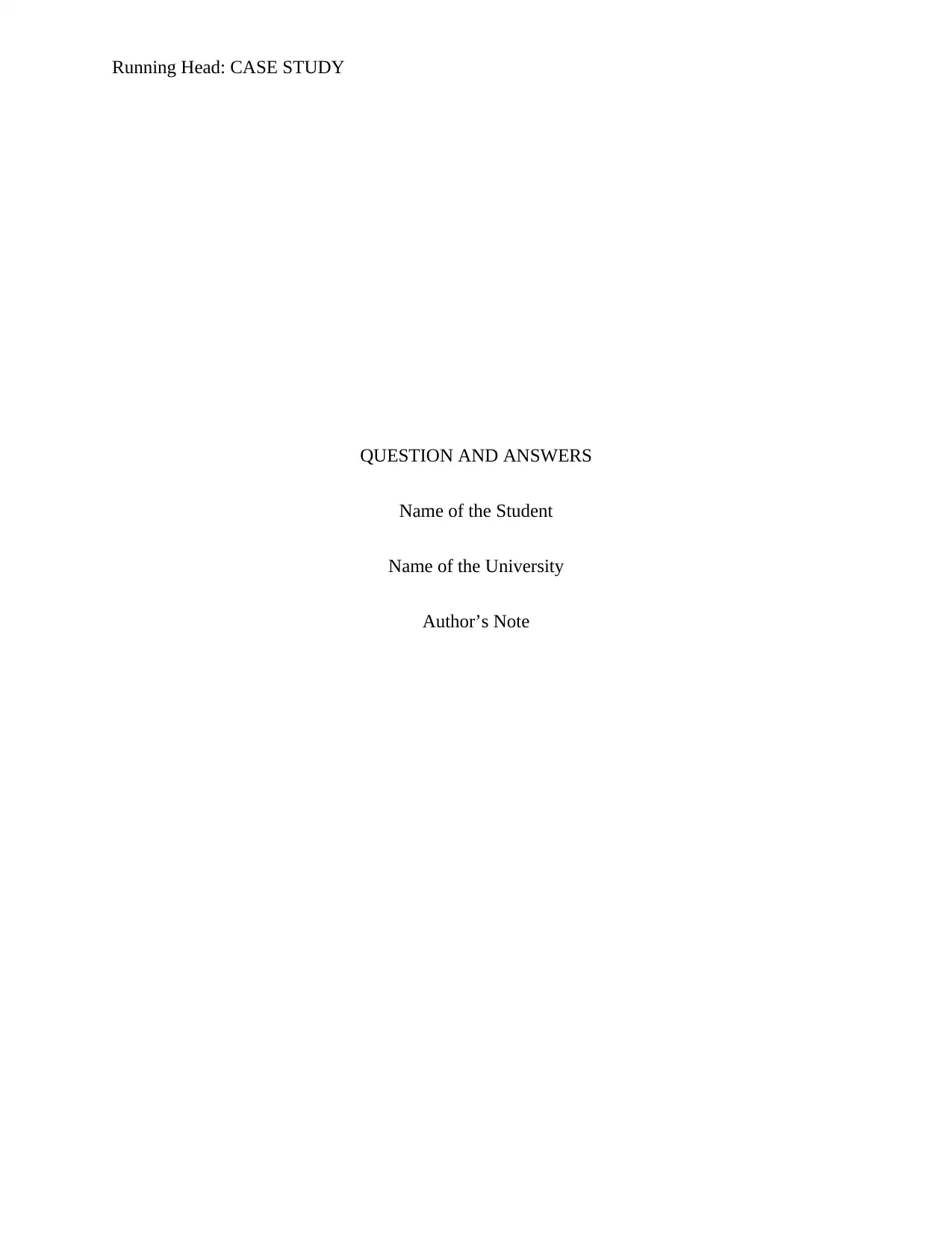
Running Head: CASE STUDY
QUESTION AND ANSWERS
Name of the Student
Name of the University
Author’s Note
QUESTION AND ANSWERS
Name of the Student
Name of the University
Author’s Note
Paraphrase This Document
Need a fresh take? Get an instant paraphrase of this document with our AI Paraphraser
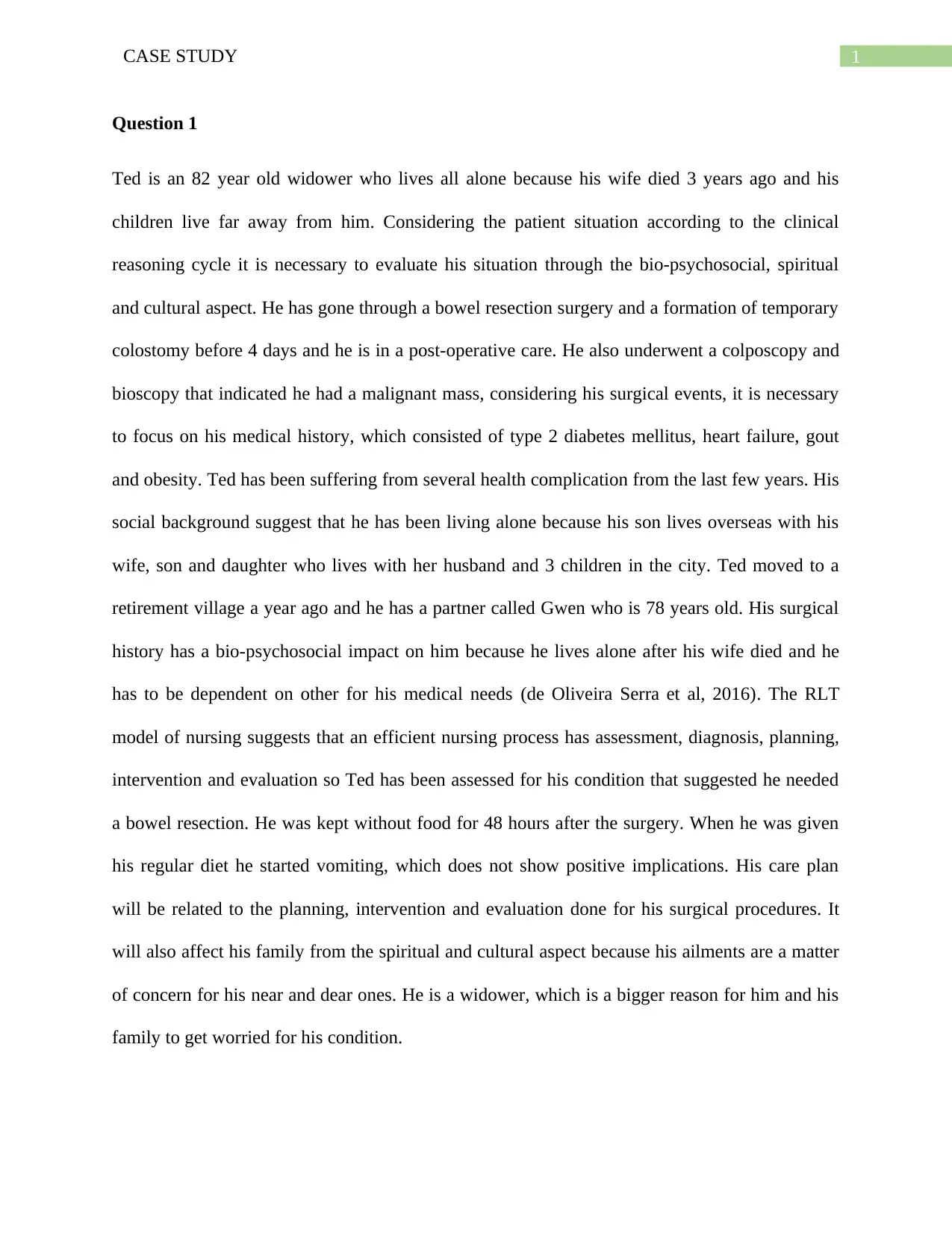
1CASE STUDY
Question 1
Ted is an 82 year old widower who lives all alone because his wife died 3 years ago and his
children live far away from him. Considering the patient situation according to the clinical
reasoning cycle it is necessary to evaluate his situation through the bio-psychosocial, spiritual
and cultural aspect. He has gone through a bowel resection surgery and a formation of temporary
colostomy before 4 days and he is in a post-operative care. He also underwent a colposcopy and
bioscopy that indicated he had a malignant mass, considering his surgical events, it is necessary
to focus on his medical history, which consisted of type 2 diabetes mellitus, heart failure, gout
and obesity. Ted has been suffering from several health complication from the last few years. His
social background suggest that he has been living alone because his son lives overseas with his
wife, son and daughter who lives with her husband and 3 children in the city. Ted moved to a
retirement village a year ago and he has a partner called Gwen who is 78 years old. His surgical
history has a bio-psychosocial impact on him because he lives alone after his wife died and he
has to be dependent on other for his medical needs (de Oliveira Serra et al, 2016). The RLT
model of nursing suggests that an efficient nursing process has assessment, diagnosis, planning,
intervention and evaluation so Ted has been assessed for his condition that suggested he needed
a bowel resection. He was kept without food for 48 hours after the surgery. When he was given
his regular diet he started vomiting, which does not show positive implications. His care plan
will be related to the planning, intervention and evaluation done for his surgical procedures. It
will also affect his family from the spiritual and cultural aspect because his ailments are a matter
of concern for his near and dear ones. He is a widower, which is a bigger reason for him and his
family to get worried for his condition.
Question 1
Ted is an 82 year old widower who lives all alone because his wife died 3 years ago and his
children live far away from him. Considering the patient situation according to the clinical
reasoning cycle it is necessary to evaluate his situation through the bio-psychosocial, spiritual
and cultural aspect. He has gone through a bowel resection surgery and a formation of temporary
colostomy before 4 days and he is in a post-operative care. He also underwent a colposcopy and
bioscopy that indicated he had a malignant mass, considering his surgical events, it is necessary
to focus on his medical history, which consisted of type 2 diabetes mellitus, heart failure, gout
and obesity. Ted has been suffering from several health complication from the last few years. His
social background suggest that he has been living alone because his son lives overseas with his
wife, son and daughter who lives with her husband and 3 children in the city. Ted moved to a
retirement village a year ago and he has a partner called Gwen who is 78 years old. His surgical
history has a bio-psychosocial impact on him because he lives alone after his wife died and he
has to be dependent on other for his medical needs (de Oliveira Serra et al, 2016). The RLT
model of nursing suggests that an efficient nursing process has assessment, diagnosis, planning,
intervention and evaluation so Ted has been assessed for his condition that suggested he needed
a bowel resection. He was kept without food for 48 hours after the surgery. When he was given
his regular diet he started vomiting, which does not show positive implications. His care plan
will be related to the planning, intervention and evaluation done for his surgical procedures. It
will also affect his family from the spiritual and cultural aspect because his ailments are a matter
of concern for his near and dear ones. He is a widower, which is a bigger reason for him and his
family to get worried for his condition.
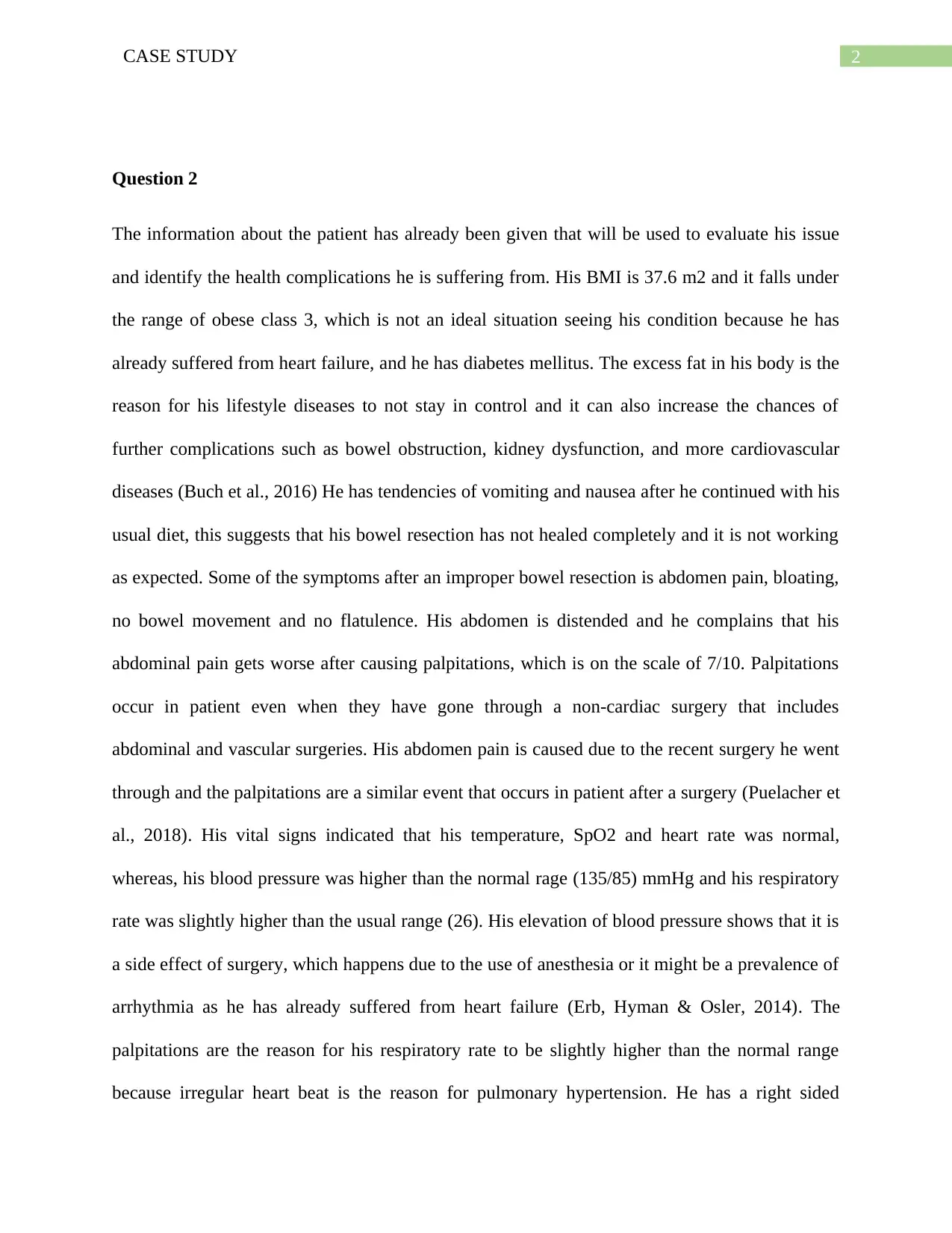
2CASE STUDY
Question 2
The information about the patient has already been given that will be used to evaluate his issue
and identify the health complications he is suffering from. His BMI is 37.6 m2 and it falls under
the range of obese class 3, which is not an ideal situation seeing his condition because he has
already suffered from heart failure, and he has diabetes mellitus. The excess fat in his body is the
reason for his lifestyle diseases to not stay in control and it can also increase the chances of
further complications such as bowel obstruction, kidney dysfunction, and more cardiovascular
diseases (Buch et al., 2016) He has tendencies of vomiting and nausea after he continued with his
usual diet, this suggests that his bowel resection has not healed completely and it is not working
as expected. Some of the symptoms after an improper bowel resection is abdomen pain, bloating,
no bowel movement and no flatulence. His abdomen is distended and he complains that his
abdominal pain gets worse after causing palpitations, which is on the scale of 7/10. Palpitations
occur in patient even when they have gone through a non-cardiac surgery that includes
abdominal and vascular surgeries. His abdomen pain is caused due to the recent surgery he went
through and the palpitations are a similar event that occurs in patient after a surgery (Puelacher et
al., 2018). His vital signs indicated that his temperature, SpO2 and heart rate was normal,
whereas, his blood pressure was higher than the normal rage (135/85) mmHg and his respiratory
rate was slightly higher than the usual range (26). His elevation of blood pressure shows that it is
a side effect of surgery, which happens due to the use of anesthesia or it might be a prevalence of
arrhythmia as he has already suffered from heart failure (Erb, Hyman & Osler, 2014). The
palpitations are the reason for his respiratory rate to be slightly higher than the normal range
because irregular heart beat is the reason for pulmonary hypertension. He has a right sided
Question 2
The information about the patient has already been given that will be used to evaluate his issue
and identify the health complications he is suffering from. His BMI is 37.6 m2 and it falls under
the range of obese class 3, which is not an ideal situation seeing his condition because he has
already suffered from heart failure, and he has diabetes mellitus. The excess fat in his body is the
reason for his lifestyle diseases to not stay in control and it can also increase the chances of
further complications such as bowel obstruction, kidney dysfunction, and more cardiovascular
diseases (Buch et al., 2016) He has tendencies of vomiting and nausea after he continued with his
usual diet, this suggests that his bowel resection has not healed completely and it is not working
as expected. Some of the symptoms after an improper bowel resection is abdomen pain, bloating,
no bowel movement and no flatulence. His abdomen is distended and he complains that his
abdominal pain gets worse after causing palpitations, which is on the scale of 7/10. Palpitations
occur in patient even when they have gone through a non-cardiac surgery that includes
abdominal and vascular surgeries. His abdomen pain is caused due to the recent surgery he went
through and the palpitations are a similar event that occurs in patient after a surgery (Puelacher et
al., 2018). His vital signs indicated that his temperature, SpO2 and heart rate was normal,
whereas, his blood pressure was higher than the normal rage (135/85) mmHg and his respiratory
rate was slightly higher than the usual range (26). His elevation of blood pressure shows that it is
a side effect of surgery, which happens due to the use of anesthesia or it might be a prevalence of
arrhythmia as he has already suffered from heart failure (Erb, Hyman & Osler, 2014). The
palpitations are the reason for his respiratory rate to be slightly higher than the normal range
because irregular heart beat is the reason for pulmonary hypertension. He has a right sided
⊘ This is a preview!⊘
Do you want full access?
Subscribe today to unlock all pages.

Trusted by 1+ million students worldwide
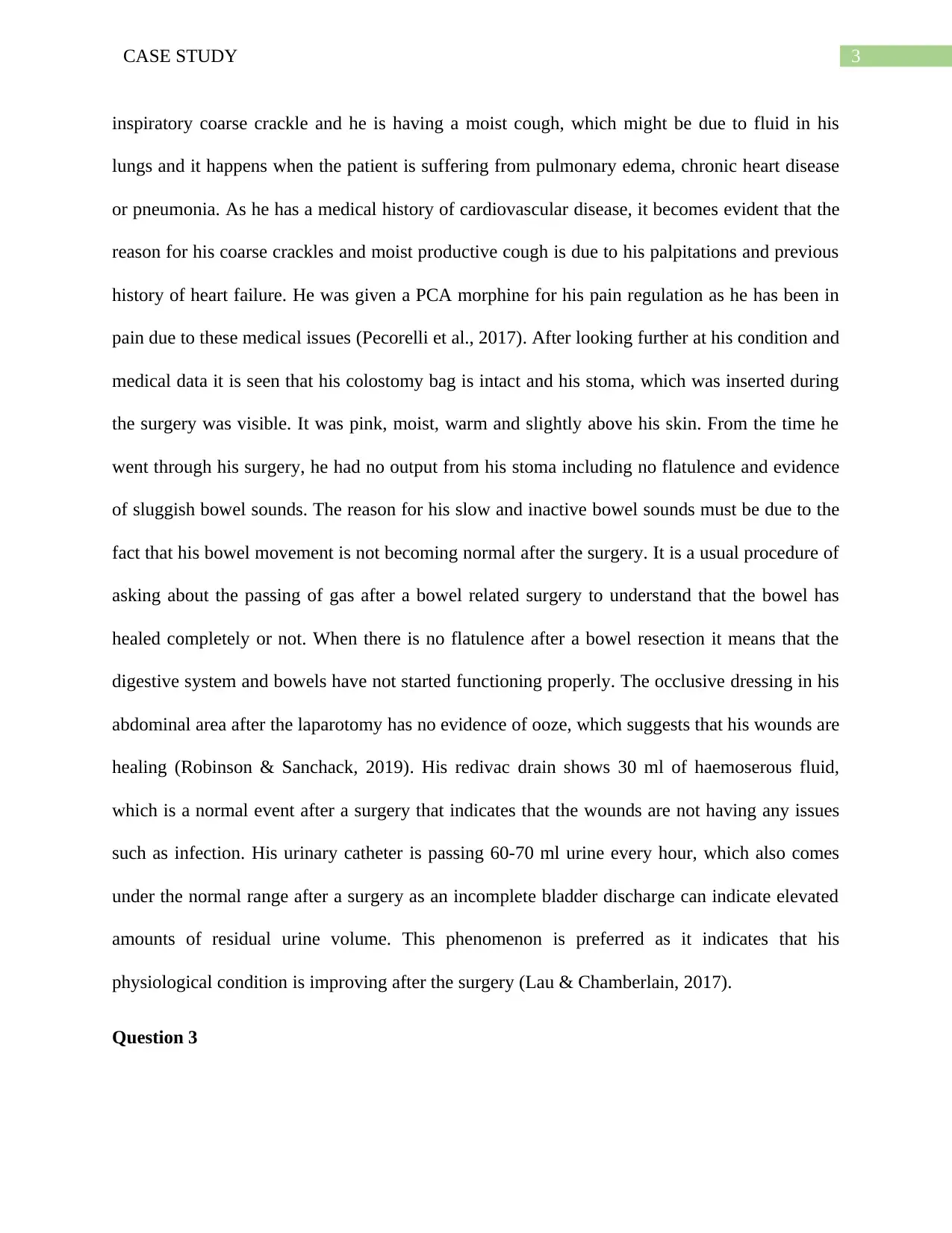
3CASE STUDY
inspiratory coarse crackle and he is having a moist cough, which might be due to fluid in his
lungs and it happens when the patient is suffering from pulmonary edema, chronic heart disease
or pneumonia. As he has a medical history of cardiovascular disease, it becomes evident that the
reason for his coarse crackles and moist productive cough is due to his palpitations and previous
history of heart failure. He was given a PCA morphine for his pain regulation as he has been in
pain due to these medical issues (Pecorelli et al., 2017). After looking further at his condition and
medical data it is seen that his colostomy bag is intact and his stoma, which was inserted during
the surgery was visible. It was pink, moist, warm and slightly above his skin. From the time he
went through his surgery, he had no output from his stoma including no flatulence and evidence
of sluggish bowel sounds. The reason for his slow and inactive bowel sounds must be due to the
fact that his bowel movement is not becoming normal after the surgery. It is a usual procedure of
asking about the passing of gas after a bowel related surgery to understand that the bowel has
healed completely or not. When there is no flatulence after a bowel resection it means that the
digestive system and bowels have not started functioning properly. The occlusive dressing in his
abdominal area after the laparotomy has no evidence of ooze, which suggests that his wounds are
healing (Robinson & Sanchack, 2019). His redivac drain shows 30 ml of haemoserous fluid,
which is a normal event after a surgery that indicates that the wounds are not having any issues
such as infection. His urinary catheter is passing 60-70 ml urine every hour, which also comes
under the normal range after a surgery as an incomplete bladder discharge can indicate elevated
amounts of residual urine volume. This phenomenon is preferred as it indicates that his
physiological condition is improving after the surgery (Lau & Chamberlain, 2017).
Question 3
inspiratory coarse crackle and he is having a moist cough, which might be due to fluid in his
lungs and it happens when the patient is suffering from pulmonary edema, chronic heart disease
or pneumonia. As he has a medical history of cardiovascular disease, it becomes evident that the
reason for his coarse crackles and moist productive cough is due to his palpitations and previous
history of heart failure. He was given a PCA morphine for his pain regulation as he has been in
pain due to these medical issues (Pecorelli et al., 2017). After looking further at his condition and
medical data it is seen that his colostomy bag is intact and his stoma, which was inserted during
the surgery was visible. It was pink, moist, warm and slightly above his skin. From the time he
went through his surgery, he had no output from his stoma including no flatulence and evidence
of sluggish bowel sounds. The reason for his slow and inactive bowel sounds must be due to the
fact that his bowel movement is not becoming normal after the surgery. It is a usual procedure of
asking about the passing of gas after a bowel related surgery to understand that the bowel has
healed completely or not. When there is no flatulence after a bowel resection it means that the
digestive system and bowels have not started functioning properly. The occlusive dressing in his
abdominal area after the laparotomy has no evidence of ooze, which suggests that his wounds are
healing (Robinson & Sanchack, 2019). His redivac drain shows 30 ml of haemoserous fluid,
which is a normal event after a surgery that indicates that the wounds are not having any issues
such as infection. His urinary catheter is passing 60-70 ml urine every hour, which also comes
under the normal range after a surgery as an incomplete bladder discharge can indicate elevated
amounts of residual urine volume. This phenomenon is preferred as it indicates that his
physiological condition is improving after the surgery (Lau & Chamberlain, 2017).
Question 3
Paraphrase This Document
Need a fresh take? Get an instant paraphrase of this document with our AI Paraphraser
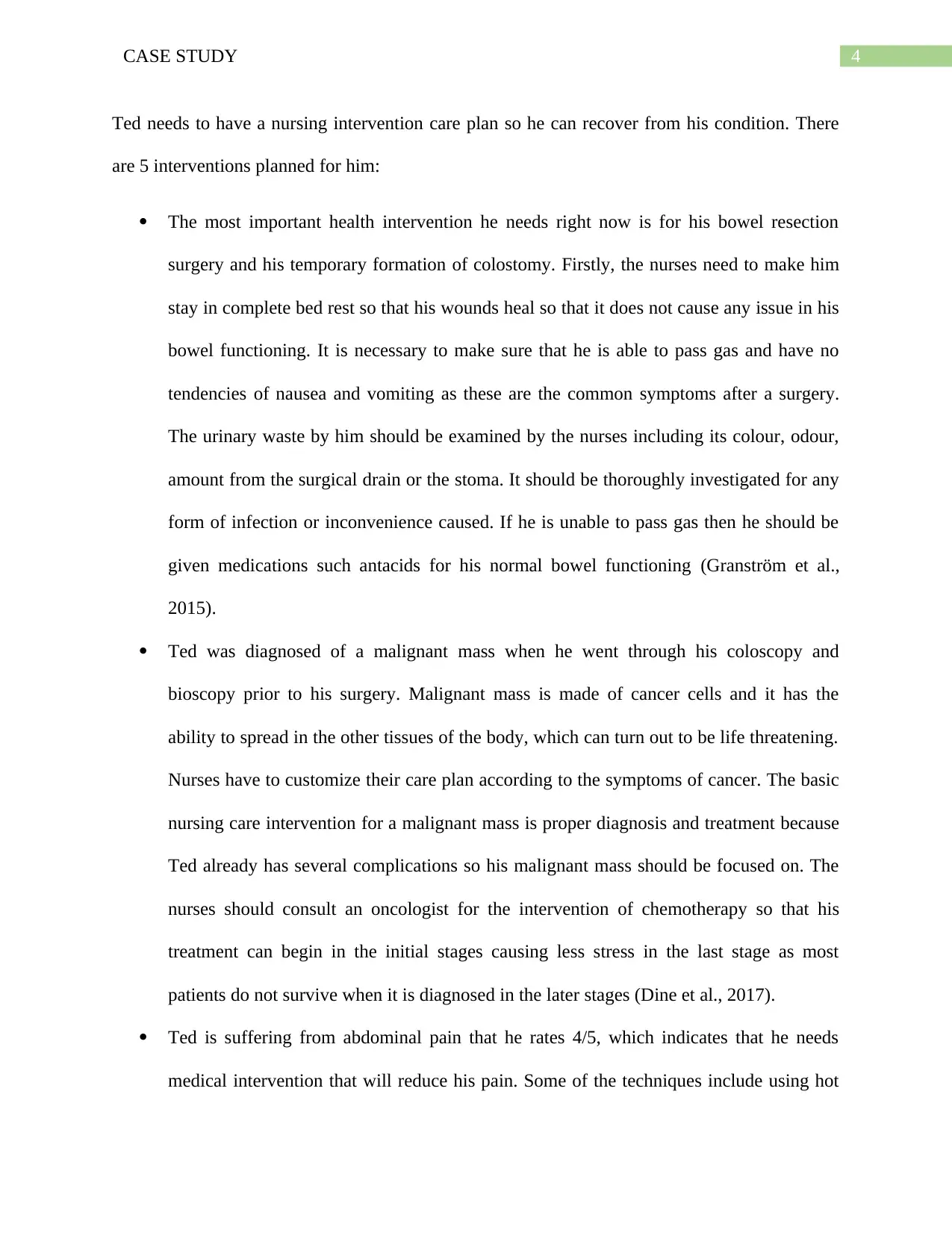
4CASE STUDY
Ted needs to have a nursing intervention care plan so he can recover from his condition. There
are 5 interventions planned for him:
The most important health intervention he needs right now is for his bowel resection
surgery and his temporary formation of colostomy. Firstly, the nurses need to make him
stay in complete bed rest so that his wounds heal so that it does not cause any issue in his
bowel functioning. It is necessary to make sure that he is able to pass gas and have no
tendencies of nausea and vomiting as these are the common symptoms after a surgery.
The urinary waste by him should be examined by the nurses including its colour, odour,
amount from the surgical drain or the stoma. It should be thoroughly investigated for any
form of infection or inconvenience caused. If he is unable to pass gas then he should be
given medications such antacids for his normal bowel functioning (Granström et al.,
2015).
Ted was diagnosed of a malignant mass when he went through his coloscopy and
bioscopy prior to his surgery. Malignant mass is made of cancer cells and it has the
ability to spread in the other tissues of the body, which can turn out to be life threatening.
Nurses have to customize their care plan according to the symptoms of cancer. The basic
nursing care intervention for a malignant mass is proper diagnosis and treatment because
Ted already has several complications so his malignant mass should be focused on. The
nurses should consult an oncologist for the intervention of chemotherapy so that his
treatment can begin in the initial stages causing less stress in the last stage as most
patients do not survive when it is diagnosed in the later stages (Dine et al., 2017).
Ted is suffering from abdominal pain that he rates 4/5, which indicates that he needs
medical intervention that will reduce his pain. Some of the techniques include using hot
Ted needs to have a nursing intervention care plan so he can recover from his condition. There
are 5 interventions planned for him:
The most important health intervention he needs right now is for his bowel resection
surgery and his temporary formation of colostomy. Firstly, the nurses need to make him
stay in complete bed rest so that his wounds heal so that it does not cause any issue in his
bowel functioning. It is necessary to make sure that he is able to pass gas and have no
tendencies of nausea and vomiting as these are the common symptoms after a surgery.
The urinary waste by him should be examined by the nurses including its colour, odour,
amount from the surgical drain or the stoma. It should be thoroughly investigated for any
form of infection or inconvenience caused. If he is unable to pass gas then he should be
given medications such antacids for his normal bowel functioning (Granström et al.,
2015).
Ted was diagnosed of a malignant mass when he went through his coloscopy and
bioscopy prior to his surgery. Malignant mass is made of cancer cells and it has the
ability to spread in the other tissues of the body, which can turn out to be life threatening.
Nurses have to customize their care plan according to the symptoms of cancer. The basic
nursing care intervention for a malignant mass is proper diagnosis and treatment because
Ted already has several complications so his malignant mass should be focused on. The
nurses should consult an oncologist for the intervention of chemotherapy so that his
treatment can begin in the initial stages causing less stress in the last stage as most
patients do not survive when it is diagnosed in the later stages (Dine et al., 2017).
Ted is suffering from abdominal pain that he rates 4/5, which indicates that he needs
medical intervention that will reduce his pain. Some of the techniques include using hot
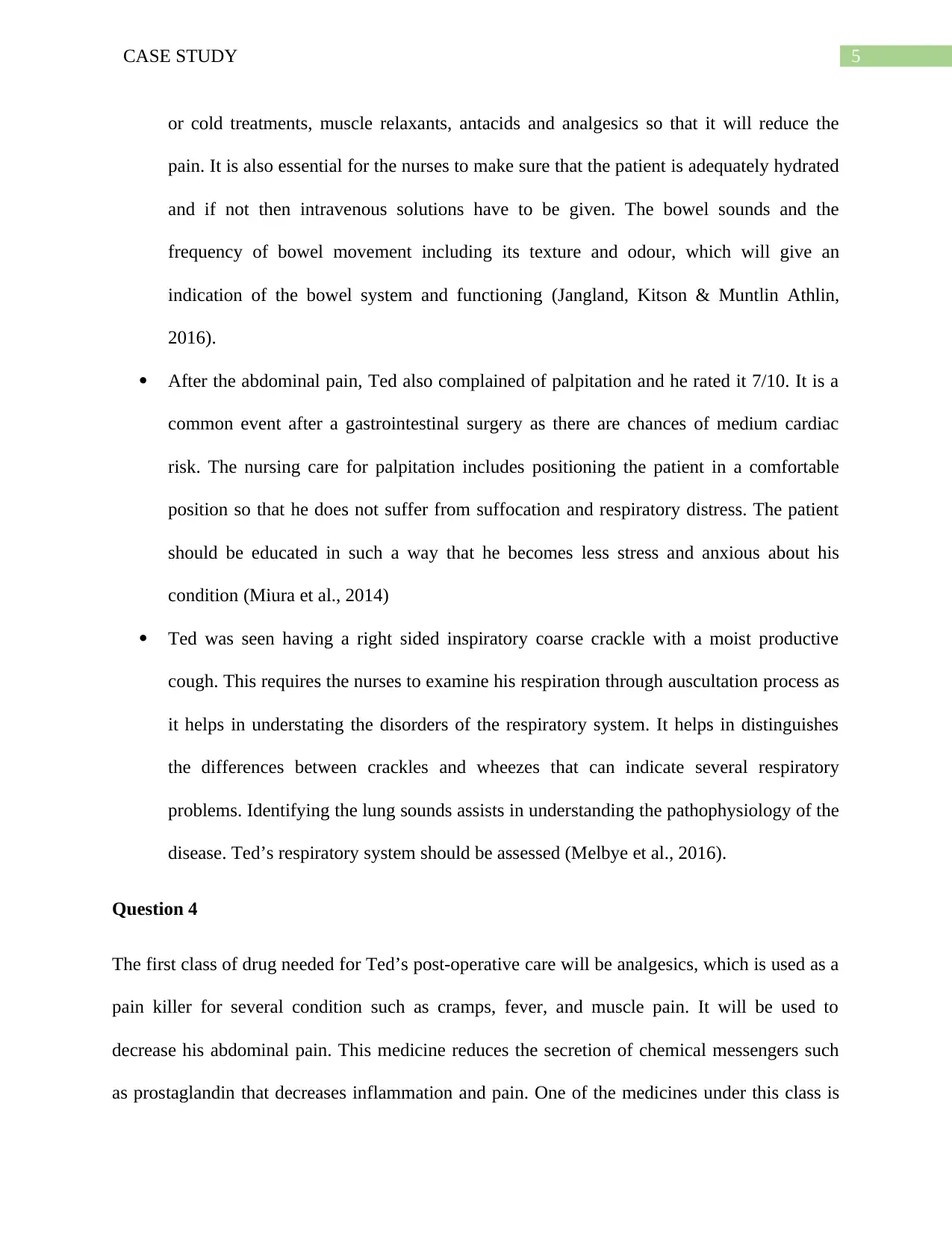
5CASE STUDY
or cold treatments, muscle relaxants, antacids and analgesics so that it will reduce the
pain. It is also essential for the nurses to make sure that the patient is adequately hydrated
and if not then intravenous solutions have to be given. The bowel sounds and the
frequency of bowel movement including its texture and odour, which will give an
indication of the bowel system and functioning (Jangland, Kitson & Muntlin Athlin,
2016).
After the abdominal pain, Ted also complained of palpitation and he rated it 7/10. It is a
common event after a gastrointestinal surgery as there are chances of medium cardiac
risk. The nursing care for palpitation includes positioning the patient in a comfortable
position so that he does not suffer from suffocation and respiratory distress. The patient
should be educated in such a way that he becomes less stress and anxious about his
condition (Miura et al., 2014)
Ted was seen having a right sided inspiratory coarse crackle with a moist productive
cough. This requires the nurses to examine his respiration through auscultation process as
it helps in understating the disorders of the respiratory system. It helps in distinguishes
the differences between crackles and wheezes that can indicate several respiratory
problems. Identifying the lung sounds assists in understanding the pathophysiology of the
disease. Ted’s respiratory system should be assessed (Melbye et al., 2016).
Question 4
The first class of drug needed for Ted’s post-operative care will be analgesics, which is used as a
pain killer for several condition such as cramps, fever, and muscle pain. It will be used to
decrease his abdominal pain. This medicine reduces the secretion of chemical messengers such
as prostaglandin that decreases inflammation and pain. One of the medicines under this class is
or cold treatments, muscle relaxants, antacids and analgesics so that it will reduce the
pain. It is also essential for the nurses to make sure that the patient is adequately hydrated
and if not then intravenous solutions have to be given. The bowel sounds and the
frequency of bowel movement including its texture and odour, which will give an
indication of the bowel system and functioning (Jangland, Kitson & Muntlin Athlin,
2016).
After the abdominal pain, Ted also complained of palpitation and he rated it 7/10. It is a
common event after a gastrointestinal surgery as there are chances of medium cardiac
risk. The nursing care for palpitation includes positioning the patient in a comfortable
position so that he does not suffer from suffocation and respiratory distress. The patient
should be educated in such a way that he becomes less stress and anxious about his
condition (Miura et al., 2014)
Ted was seen having a right sided inspiratory coarse crackle with a moist productive
cough. This requires the nurses to examine his respiration through auscultation process as
it helps in understating the disorders of the respiratory system. It helps in distinguishes
the differences between crackles and wheezes that can indicate several respiratory
problems. Identifying the lung sounds assists in understanding the pathophysiology of the
disease. Ted’s respiratory system should be assessed (Melbye et al., 2016).
Question 4
The first class of drug needed for Ted’s post-operative care will be analgesics, which is used as a
pain killer for several condition such as cramps, fever, and muscle pain. It will be used to
decrease his abdominal pain. This medicine reduces the secretion of chemical messengers such
as prostaglandin that decreases inflammation and pain. One of the medicines under this class is
⊘ This is a preview!⊘
Do you want full access?
Subscribe today to unlock all pages.

Trusted by 1+ million students worldwide
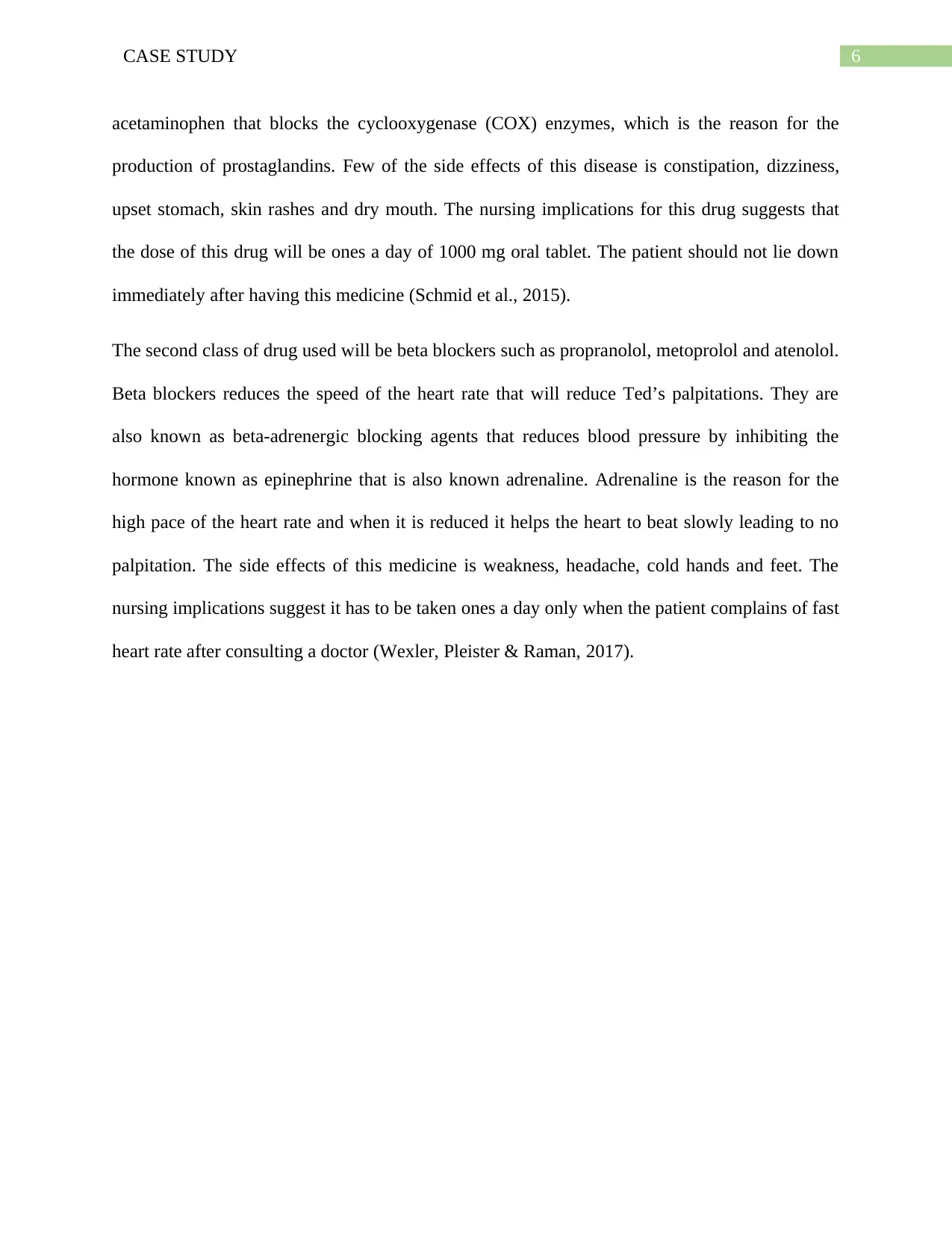
6CASE STUDY
acetaminophen that blocks the cyclooxygenase (COX) enzymes, which is the reason for the
production of prostaglandins. Few of the side effects of this disease is constipation, dizziness,
upset stomach, skin rashes and dry mouth. The nursing implications for this drug suggests that
the dose of this drug will be ones a day of 1000 mg oral tablet. The patient should not lie down
immediately after having this medicine (Schmid et al., 2015).
The second class of drug used will be beta blockers such as propranolol, metoprolol and atenolol.
Beta blockers reduces the speed of the heart rate that will reduce Ted’s palpitations. They are
also known as beta-adrenergic blocking agents that reduces blood pressure by inhibiting the
hormone known as epinephrine that is also known adrenaline. Adrenaline is the reason for the
high pace of the heart rate and when it is reduced it helps the heart to beat slowly leading to no
palpitation. The side effects of this medicine is weakness, headache, cold hands and feet. The
nursing implications suggest it has to be taken ones a day only when the patient complains of fast
heart rate after consulting a doctor (Wexler, Pleister & Raman, 2017).
acetaminophen that blocks the cyclooxygenase (COX) enzymes, which is the reason for the
production of prostaglandins. Few of the side effects of this disease is constipation, dizziness,
upset stomach, skin rashes and dry mouth. The nursing implications for this drug suggests that
the dose of this drug will be ones a day of 1000 mg oral tablet. The patient should not lie down
immediately after having this medicine (Schmid et al., 2015).
The second class of drug used will be beta blockers such as propranolol, metoprolol and atenolol.
Beta blockers reduces the speed of the heart rate that will reduce Ted’s palpitations. They are
also known as beta-adrenergic blocking agents that reduces blood pressure by inhibiting the
hormone known as epinephrine that is also known adrenaline. Adrenaline is the reason for the
high pace of the heart rate and when it is reduced it helps the heart to beat slowly leading to no
palpitation. The side effects of this medicine is weakness, headache, cold hands and feet. The
nursing implications suggest it has to be taken ones a day only when the patient complains of fast
heart rate after consulting a doctor (Wexler, Pleister & Raman, 2017).
Paraphrase This Document
Need a fresh take? Get an instant paraphrase of this document with our AI Paraphraser
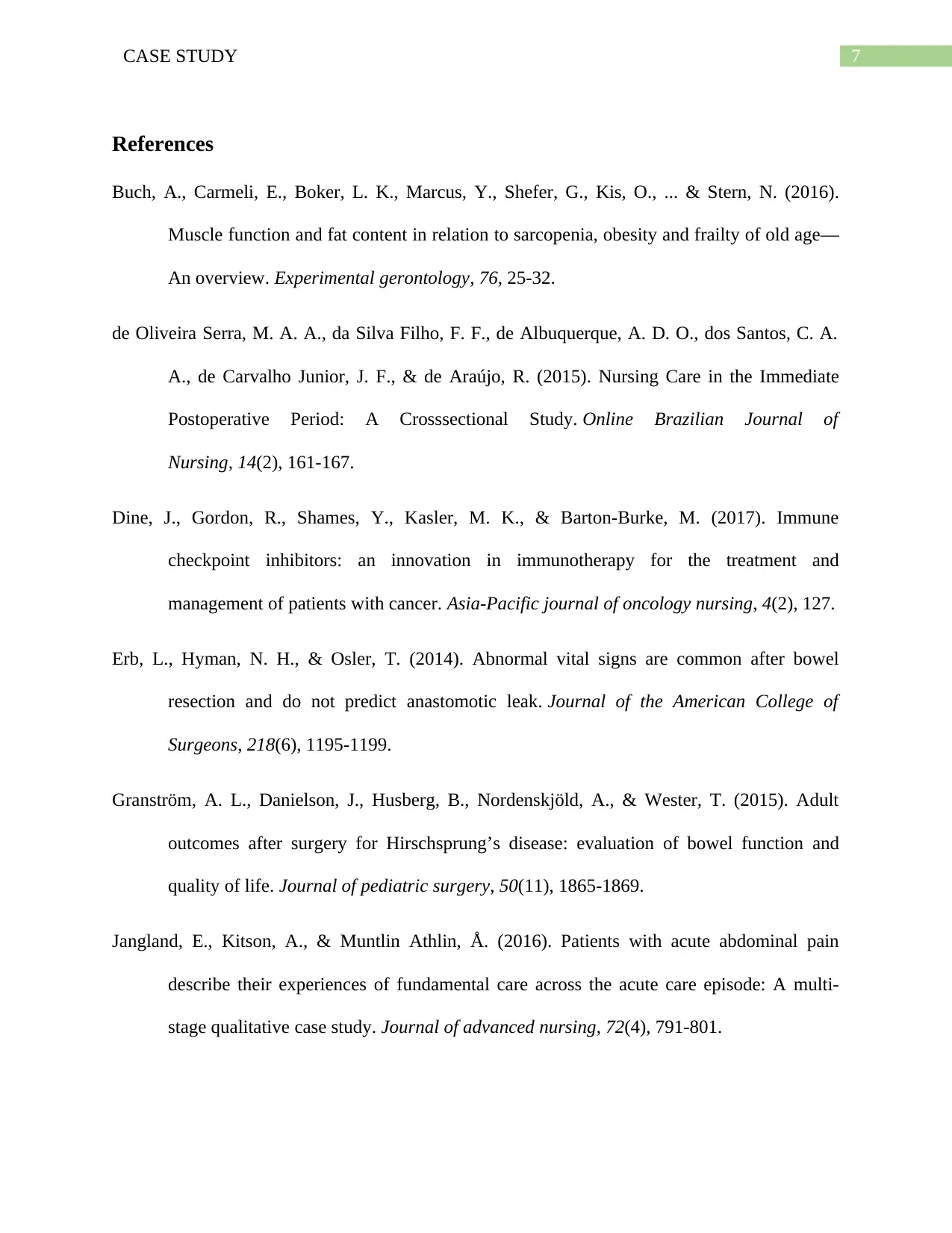
7CASE STUDY
References
Buch, A., Carmeli, E., Boker, L. K., Marcus, Y., Shefer, G., Kis, O., ... & Stern, N. (2016).
Muscle function and fat content in relation to sarcopenia, obesity and frailty of old age—
An overview. Experimental gerontology, 76, 25-32.
de Oliveira Serra, M. A. A., da Silva Filho, F. F., de Albuquerque, A. D. O., dos Santos, C. A.
A., de Carvalho Junior, J. F., & de Araújo, R. (2015). Nursing Care in the Immediate
Postoperative Period: A Crosssectional Study. Online Brazilian Journal of
Nursing, 14(2), 161-167.
Dine, J., Gordon, R., Shames, Y., Kasler, M. K., & Barton-Burke, M. (2017). Immune
checkpoint inhibitors: an innovation in immunotherapy for the treatment and
management of patients with cancer. Asia-Pacific journal of oncology nursing, 4(2), 127.
Erb, L., Hyman, N. H., & Osler, T. (2014). Abnormal vital signs are common after bowel
resection and do not predict anastomotic leak. Journal of the American College of
Surgeons, 218(6), 1195-1199.
Granström, A. L., Danielson, J., Husberg, B., Nordenskjöld, A., & Wester, T. (2015). Adult
outcomes after surgery for Hirschsprung’s disease: evaluation of bowel function and
quality of life. Journal of pediatric surgery, 50(11), 1865-1869.
Jangland, E., Kitson, A., & Muntlin Athlin, Å. (2016). Patients with acute abdominal pain
describe their experiences of fundamental care across the acute care episode: A multi‐
stage qualitative case study. Journal of advanced nursing, 72(4), 791-801.
References
Buch, A., Carmeli, E., Boker, L. K., Marcus, Y., Shefer, G., Kis, O., ... & Stern, N. (2016).
Muscle function and fat content in relation to sarcopenia, obesity and frailty of old age—
An overview. Experimental gerontology, 76, 25-32.
de Oliveira Serra, M. A. A., da Silva Filho, F. F., de Albuquerque, A. D. O., dos Santos, C. A.
A., de Carvalho Junior, J. F., & de Araújo, R. (2015). Nursing Care in the Immediate
Postoperative Period: A Crosssectional Study. Online Brazilian Journal of
Nursing, 14(2), 161-167.
Dine, J., Gordon, R., Shames, Y., Kasler, M. K., & Barton-Burke, M. (2017). Immune
checkpoint inhibitors: an innovation in immunotherapy for the treatment and
management of patients with cancer. Asia-Pacific journal of oncology nursing, 4(2), 127.
Erb, L., Hyman, N. H., & Osler, T. (2014). Abnormal vital signs are common after bowel
resection and do not predict anastomotic leak. Journal of the American College of
Surgeons, 218(6), 1195-1199.
Granström, A. L., Danielson, J., Husberg, B., Nordenskjöld, A., & Wester, T. (2015). Adult
outcomes after surgery for Hirschsprung’s disease: evaluation of bowel function and
quality of life. Journal of pediatric surgery, 50(11), 1865-1869.
Jangland, E., Kitson, A., & Muntlin Athlin, Å. (2016). Patients with acute abdominal pain
describe their experiences of fundamental care across the acute care episode: A multi‐
stage qualitative case study. Journal of advanced nursing, 72(4), 791-801.
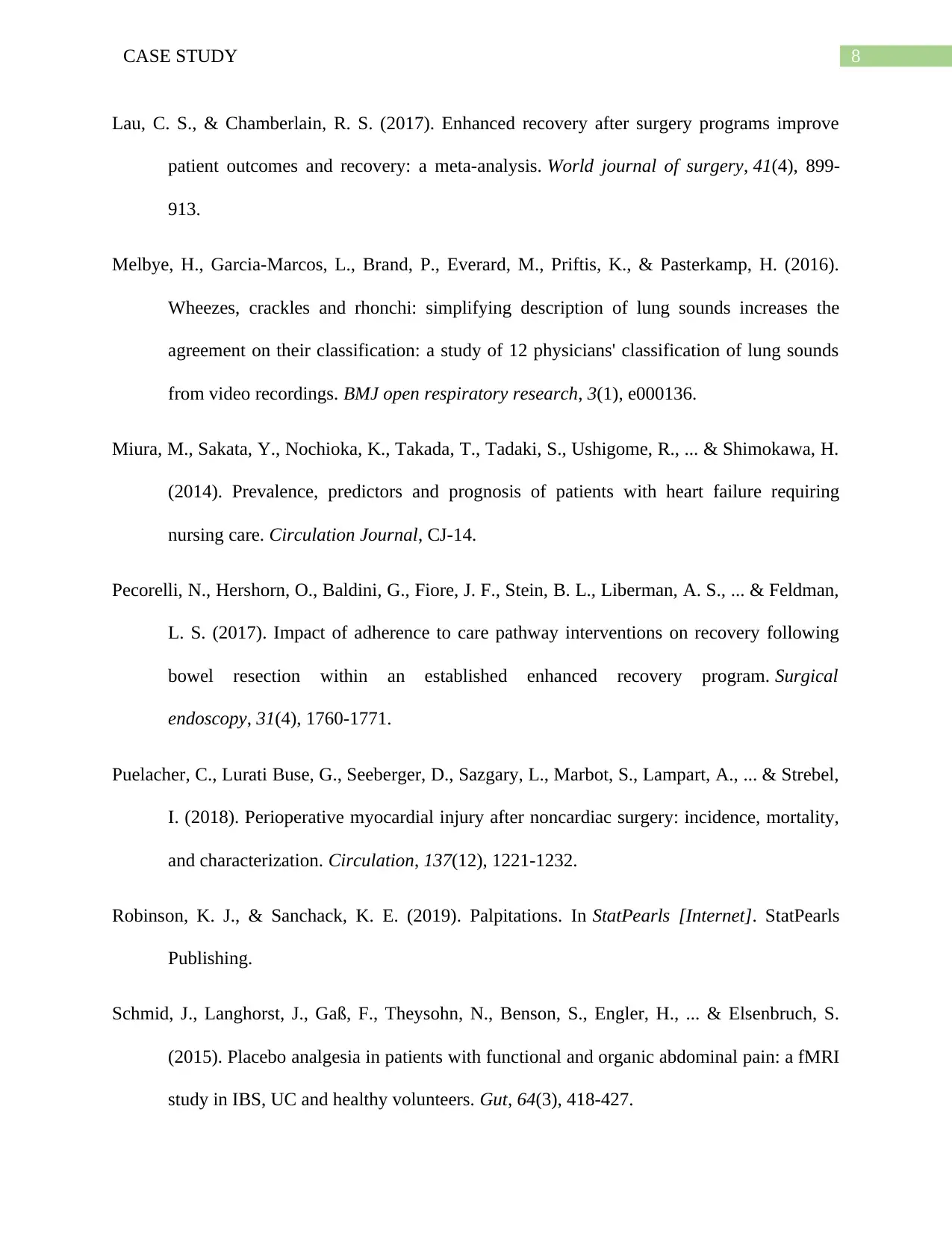
8CASE STUDY
Lau, C. S., & Chamberlain, R. S. (2017). Enhanced recovery after surgery programs improve
patient outcomes and recovery: a meta-analysis. World journal of surgery, 41(4), 899-
913.
Melbye, H., Garcia-Marcos, L., Brand, P., Everard, M., Priftis, K., & Pasterkamp, H. (2016).
Wheezes, crackles and rhonchi: simplifying description of lung sounds increases the
agreement on their classification: a study of 12 physicians' classification of lung sounds
from video recordings. BMJ open respiratory research, 3(1), e000136.
Miura, M., Sakata, Y., Nochioka, K., Takada, T., Tadaki, S., Ushigome, R., ... & Shimokawa, H.
(2014). Prevalence, predictors and prognosis of patients with heart failure requiring
nursing care. Circulation Journal, CJ-14.
Pecorelli, N., Hershorn, O., Baldini, G., Fiore, J. F., Stein, B. L., Liberman, A. S., ... & Feldman,
L. S. (2017). Impact of adherence to care pathway interventions on recovery following
bowel resection within an established enhanced recovery program. Surgical
endoscopy, 31(4), 1760-1771.
Puelacher, C., Lurati Buse, G., Seeberger, D., Sazgary, L., Marbot, S., Lampart, A., ... & Strebel,
I. (2018). Perioperative myocardial injury after noncardiac surgery: incidence, mortality,
and characterization. Circulation, 137(12), 1221-1232.
Robinson, K. J., & Sanchack, K. E. (2019). Palpitations. In StatPearls [Internet]. StatPearls
Publishing.
Schmid, J., Langhorst, J., Gaß, F., Theysohn, N., Benson, S., Engler, H., ... & Elsenbruch, S.
(2015). Placebo analgesia in patients with functional and organic abdominal pain: a fMRI
study in IBS, UC and healthy volunteers. Gut, 64(3), 418-427.
Lau, C. S., & Chamberlain, R. S. (2017). Enhanced recovery after surgery programs improve
patient outcomes and recovery: a meta-analysis. World journal of surgery, 41(4), 899-
913.
Melbye, H., Garcia-Marcos, L., Brand, P., Everard, M., Priftis, K., & Pasterkamp, H. (2016).
Wheezes, crackles and rhonchi: simplifying description of lung sounds increases the
agreement on their classification: a study of 12 physicians' classification of lung sounds
from video recordings. BMJ open respiratory research, 3(1), e000136.
Miura, M., Sakata, Y., Nochioka, K., Takada, T., Tadaki, S., Ushigome, R., ... & Shimokawa, H.
(2014). Prevalence, predictors and prognosis of patients with heart failure requiring
nursing care. Circulation Journal, CJ-14.
Pecorelli, N., Hershorn, O., Baldini, G., Fiore, J. F., Stein, B. L., Liberman, A. S., ... & Feldman,
L. S. (2017). Impact of adherence to care pathway interventions on recovery following
bowel resection within an established enhanced recovery program. Surgical
endoscopy, 31(4), 1760-1771.
Puelacher, C., Lurati Buse, G., Seeberger, D., Sazgary, L., Marbot, S., Lampart, A., ... & Strebel,
I. (2018). Perioperative myocardial injury after noncardiac surgery: incidence, mortality,
and characterization. Circulation, 137(12), 1221-1232.
Robinson, K. J., & Sanchack, K. E. (2019). Palpitations. In StatPearls [Internet]. StatPearls
Publishing.
Schmid, J., Langhorst, J., Gaß, F., Theysohn, N., Benson, S., Engler, H., ... & Elsenbruch, S.
(2015). Placebo analgesia in patients with functional and organic abdominal pain: a fMRI
study in IBS, UC and healthy volunteers. Gut, 64(3), 418-427.
⊘ This is a preview!⊘
Do you want full access?
Subscribe today to unlock all pages.

Trusted by 1+ million students worldwide
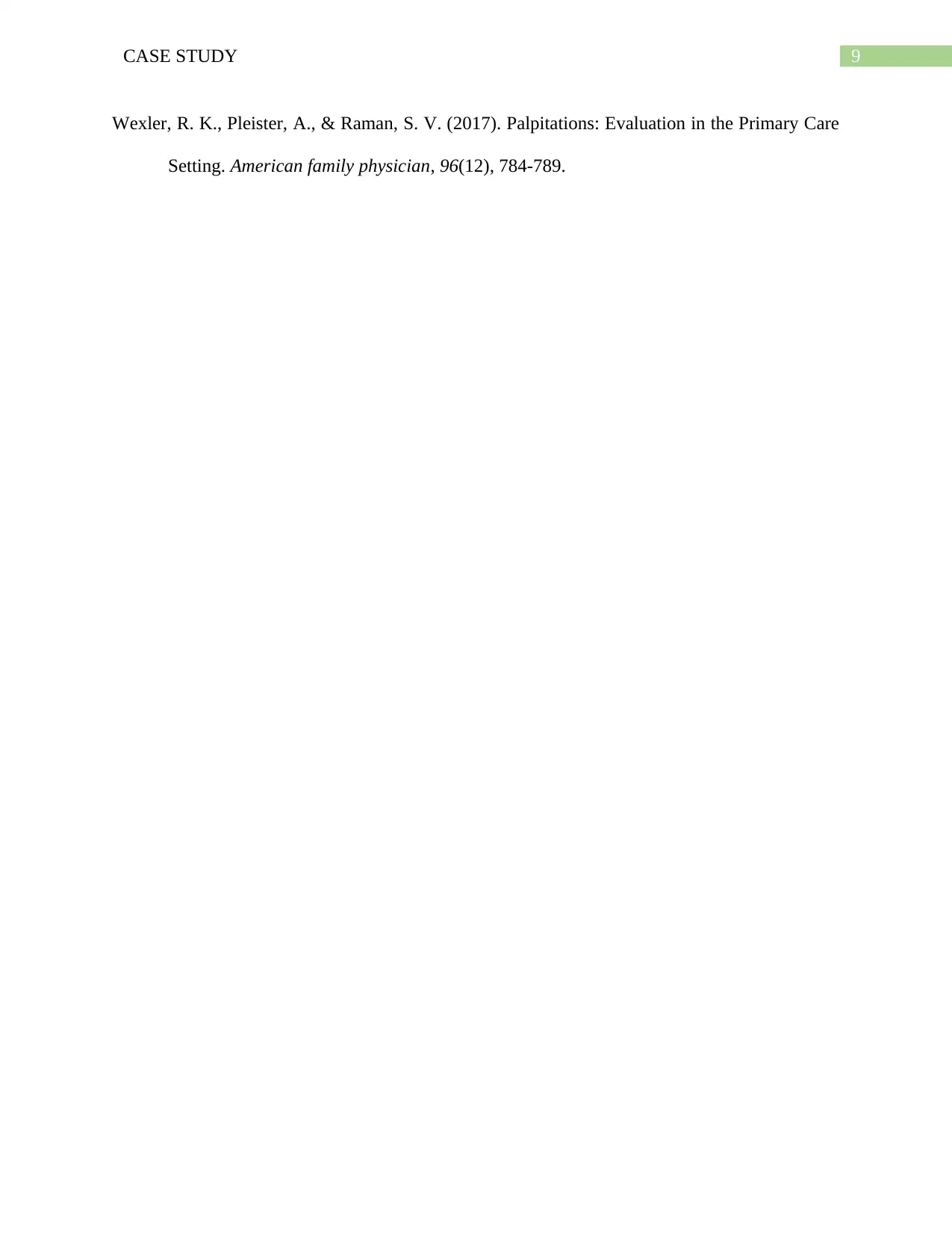
9CASE STUDY
Wexler, R. K., Pleister, A., & Raman, S. V. (2017). Palpitations: Evaluation in the Primary Care
Setting. American family physician, 96(12), 784-789.
Wexler, R. K., Pleister, A., & Raman, S. V. (2017). Palpitations: Evaluation in the Primary Care
Setting. American family physician, 96(12), 784-789.
1 out of 10
Related Documents
Your All-in-One AI-Powered Toolkit for Academic Success.
+13062052269
info@desklib.com
Available 24*7 on WhatsApp / Email
![[object Object]](/_next/static/media/star-bottom.7253800d.svg)
Unlock your academic potential
Copyright © 2020–2025 A2Z Services. All Rights Reserved. Developed and managed by ZUCOL.





